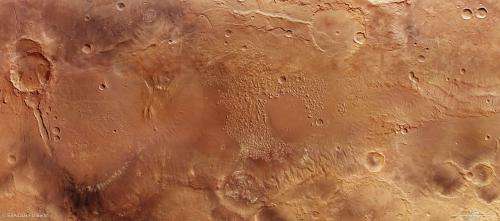ESA image: Chaos in Atlantis basin

Mars is peppered with craters. Scientists have deduced that the red planet is struck by around 200 meteoroids every year that dig out new craters.
While some small craters are fresh, Mars has a great many that are much larger and more ancient, such as the roughly circular patch of terrain, partially encircled by wrinkled cliffs, shown at the centre of this image. Named Atlantis basin, this crater is so old that its outer rim has eroded and is now barely detectable. It is thought to be the result of a massive collision some 4 billion years ago, during the 'Late Heavy Bombardment' – a period when an unusually high number of asteroids rained down on the rocky inner Solar System planets.
The Atlantis basin is located in the southern highlands of Mars. Many different structures and geological features can be found across this region of the planet, a number of which are shown in this image such as cliffs, impact craters, channels carved into steep slopes, wrinkled ridges and scarps.
Perhaps the most prominent feature is the speckling of uneven terrain towards the centre of this image. This is Atlantis Chaos, a lowland plain covering around 170 km by 145 km, and containing a few hundred small peaks and flat-topped hills known as 'mesas'. These sandy-coloured mounds are thought to result from the slow erosion of a once-continuous solid plateau.
There are several other large basins in this part of Mars that appear to be partially connected. Geologists believe that these basins may have been filled with water in the past to create the hypothetical far-reaching Eridania lake, which would have covered an area of over a million square kilometres, about the size of France and Spain combined.
There is also evidence from Mars Express and other spacecraft that deposits in one of these nearby basins contain minerals that are produced in the presence of water, and are similar to those found in some types of clay on Earth. This, along with the deep channels and ridges carved into the basin slopes seen towards the bottom of this image, for example, suggest the past existence of water in the Atlantis basin and surrounding region.
This image is a mosaic of four images taken by the Mars Express High Resolution Stereo Camera on 28 December 2008, 29 December 2008, 6 February 2009 and 5 January 2014. The image resolution is roughly 14 m per pixel.
Provided by European Space Agency





















